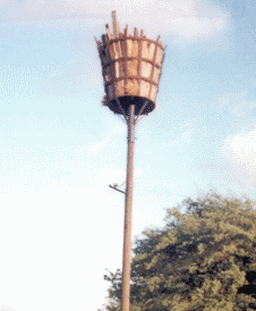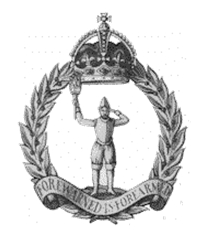BACKGROUND - "THE D.N.A OF THE R.O.C"

Signalling Beacon
“Forewarned is Forearmed” – The Beacon System
Prior to the development of the aeroplane, the greatest fear of attack was from the sea. Fire beacons to warn of attack have been used since primitive times to warn of impending attack and the same idea formed the basis of the ROC's modus operandi. Although the use of signalling by fire has its origins dating back to the Romans, the use of fire in the form of lighted beacons was effectively used during the reign of Edward II (1307-1327) when fire signals was used on the Isle of Wight to warn of the return of his wife Queen Isabella who conspired with the English Barons to dethrone him.
It was however not until 1372 when a system of organised warning beacons on high points across the country was ordered by Edward IV. The purpose of which was to warn ports and signify a call to arms for the “countywide” spread of militia in the event of invasion of the country. “Bekyns” as they were initially known were deemed to provide a far faster and effective warning “message” than a messenger struggling along difficult and dangerous tracks on horseback. Locations of these "bekyns" were located on high ground so as to be able to be seen from great distance. Hills, castles and church roofs formed the favourite locations, however horsemen were held in reserve if visibility was poor.
Sites were managed on a regular basis with local Shires having the responsibility for maintenance, provision of materials to generate the fires and to pay the watchers who kept a 24-hour “watch” during the majority of the year. The system was not foolproof; and when in 1545, as a result of rumours spreading of a French invasion on the South Coast, beacons were lit, the Worcestershire militia consisting of an army of labourers and farm-workers, often armed with nothing more than a scythe or an axe, tramped all the way to Swindon before they were told it was a false alarm.
The Spanish Armada
King Philip II of Spain had been king consort of England until the death in 1558 of his wife, Queen Mary I of England. Taking exception to the policies pursued by her successor, his sister-in-law Elizabeth I, he planned to invade and conquer England, thereby suppressing support for the United Provinces – that part of the Spanish Netherlands in possession of the Dutch rebels – and cutting off attacks by the English against Spanish possessions in the New World and against the Atlantic treasure fleets. The king was supported by Pope Sixtus V, who treated the invasion as a crusade; with the promise of a further subsidy should the Armada make land. On 28th May 1588 the Spanish Armada set sail from Lisbon, headed for the English Channel. The fleet consisted of approximately:-
Prior to the development of the aeroplane, the greatest fear of attack was from the sea. Fire beacons to warn of attack have been used since primitive times to warn of impending attack and the same idea formed the basis of the ROC's modus operandi. Although the use of signalling by fire has its origins dating back to the Romans, the use of fire in the form of lighted beacons was effectively used during the reign of Edward II (1307-1327) when fire signals was used on the Isle of Wight to warn of the return of his wife Queen Isabella who conspired with the English Barons to dethrone him.
It was however not until 1372 when a system of organised warning beacons on high points across the country was ordered by Edward IV. The purpose of which was to warn ports and signify a call to arms for the “countywide” spread of militia in the event of invasion of the country. “Bekyns” as they were initially known were deemed to provide a far faster and effective warning “message” than a messenger struggling along difficult and dangerous tracks on horseback. Locations of these "bekyns" were located on high ground so as to be able to be seen from great distance. Hills, castles and church roofs formed the favourite locations, however horsemen were held in reserve if visibility was poor.
Sites were managed on a regular basis with local Shires having the responsibility for maintenance, provision of materials to generate the fires and to pay the watchers who kept a 24-hour “watch” during the majority of the year. The system was not foolproof; and when in 1545, as a result of rumours spreading of a French invasion on the South Coast, beacons were lit, the Worcestershire militia consisting of an army of labourers and farm-workers, often armed with nothing more than a scythe or an axe, tramped all the way to Swindon before they were told it was a false alarm.
The Spanish Armada
King Philip II of Spain had been king consort of England until the death in 1558 of his wife, Queen Mary I of England. Taking exception to the policies pursued by her successor, his sister-in-law Elizabeth I, he planned to invade and conquer England, thereby suppressing support for the United Provinces – that part of the Spanish Netherlands in possession of the Dutch rebels – and cutting off attacks by the English against Spanish possessions in the New World and against the Atlantic treasure fleets. The king was supported by Pope Sixtus V, who treated the invasion as a crusade; with the promise of a further subsidy should the Armada make land. On 28th May 1588 the Spanish Armada set sail from Lisbon, headed for the English Channel. The fleet consisted of approximately:-
- 130 Ships
- 8,000 Sailors & 18,000 Soldiers
- 1,500 brass & 1,000 Iron Guns
It was not until 19th July 1588, when the Spanish Armada was seen sailing up the English Channel from a watch post located at the top of St Michael’s Mount near Penzance, Cornwall. From this moment the network of beacons which had been set up on the hilltops, church towers and castles along the South Coast were lit to warn of the threat of the incoming Spanish invasion. News of the invasion was conveyed to London which gave extra time to organise retaliatory forces.
On 29th July 1588 the two fleets met in battle off Gravelines. The English emerged victorious from the battle even though Spanish losses were not great; three ships were sunk, one captured, and four more ran aground. As a result of this defeat, the Duke of Medina Sedonia decided that the Armada must return to Spain. The English blocked the Channel, so that the only route open to the Spanish was north around the tip of Scotland, and down the coast of Ireland. It was then that the unpredictable British weather took a hand in the proceedings. A succession of storms scattered the Spanish ships, resulting in shipwrecks and heavy losses.
By the time the tattered Armada regained Spain, it had lost half its ships and three-quarters of its men. In England the victory was greeted as a sign of divine approval for the Protestant cause. The storms that scattered the Armada were seen as intervention by God with ‘services of thanks’ being held throughout the country, and a commemorative medal struck, with the words inscribed ... "God blew and they were scattered"
The war continued for a further fifteen years. The beacon system along the South Coast was hailed as a success and formed the main focus of further beacons across the country during this period and as a basis for warning of further invasion during the subsequent war with France in 1792. It is from the operational success of this network of beacons that the badge of the Royal Observer Corps is derived; depicting a beacon lighter of Elizabethan times and utilising the old adage ... “Forewarned is Forearmed”.
